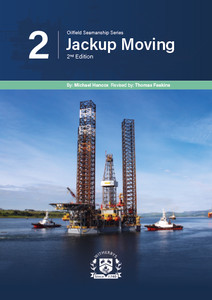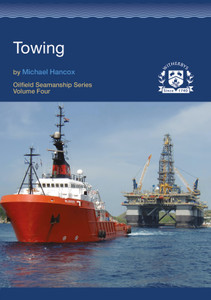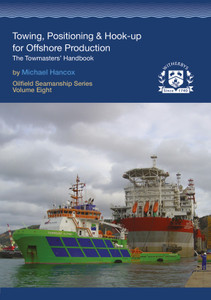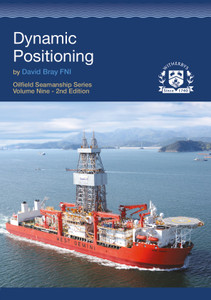
This book has been written to provide the Master of a tug with essential knowledge and techniques that can be applied when connecting a tug to a MODU which requires rescue towing, or a vessel requiring a tow within an oilfield. Previously published by Clarkson Research Services Ltd.
The purpose of this book is to provide practical seamanship guidance to Masters and crews of salvage, anchor handling and other tugs planning and conducting rescue towage within, and in close proximity to, oilfields. The personnel and crew serving on vessels and MODUs within oilfields will also learn how tugs operate during rescue towage. When planning for contingencies, both from a shoreside and a vessel perspective, this publication will assist in providing an overview of methods available for reconnection and other options that vessels find most practicable. Rescue towing in the context of this publication includes reconnection by a tug to a towed object when the original towline is broken, assisting another tug that has lost control of its tow, when additional tow power is required or when towage services can be offered to a vessel or unit requiring the services of a tug to avoid marine peril. This is not a definitive guide for professional salvors.
The purpose of this book is to provide practical seamanship guidance to Masters and crews of salvage, anchor handling and other tugs planning and conducting rescue towage within, and in close proximity to, oilfields. The personnel and crew serving on vessels and MODUs within oilfields will also learn how tugs operate during rescue towage. When planning for contingencies, both from a shoreside and a vessel perspective, this publication will assist in providing an overview of methods available for
re-connection and other options that vessels find most practicable. Rescue towing in the context of this publication includes reconnection by a tug to a towed object when the original towline is broken, assisting another tug that has lost control of its tow, when additional tow power is required or when towage services can be offered to a vessel or unit requiring the services of a tug to avoid marine peril. This is not a definitive guide for professional salvors.
Oilfields present many challenges for any rescue operation and every situation will be unique, for
example, whether or not the vessel being rescued is manned, what gear it has on board, weather conditions and the proximity of surface and subsea assets. The marine environment is constantly changing and the prudent Master and crew should select the most appropriate method for their particular situation. The requirement for oilfield towage has changed significantly since the 1993 edition of this volume was published. Most vessels operating in close proximity to oilfield assets now use dynamic positioning (DP) and with the advent of DP came increased redundancy. As a result, the likelihood of rescue towage reduced, although there are still occasions where rescue towage may be required, such as was the caes for the ‘Vindo’ (2007), ‘Kulluk’ (2010), ‘Grampian Venture’ (2014),‘Transocean Winner’ (2016) and ‘Safe Bristolia’ (2016).
The North Sea has often been regarded as an example to other countries of oilfield operations and the North West European Area (NWEA) Guidance became the Guidelines for Offshore Marine Operations (GOMO). In the same way, while this publication concentrates on North Sea operations, the methods can be transferred to oilfields worldwide.
Over the last 10 years a growing number of marine renewable sites have emerged around the world, which present similar, and in some cases additional, hazards to those experienced in oilfields. The methods described in this publication also serve as a guide to any rescue towage operation within and close to renewables construction sites.
When conducting towage, and specifically rescue towage, the safety of those on deck should always be at the forefront of the mind of the Master, or mate, driving the tug. There are numerous hazards involved, which for a new crew member or the outside observer may seem overwhelming, but those with experience in the tasks rely on skills, knowledge and good seamanship to conduct the rescue tow without endangering any lives.
The Salvage Convention does not include MODUs, so the term ‘rescue towing’ is used throughout this publication to describe any towage (or salvage) of any vessel, including on MODU.
The capabilities of the tugs in rescue towing depends on the skillset of the Master and crew, the propulsion and power available and whether they have the basic amount of towing gear on board. They should also have both the knowledge and ability to safely use their vessels and crews when executing the connection, position holding and rescue towage.
The intention of this publication is to provide details, with the assistance of annotated diagrams and photographs, of some proven methods of conducting rescue towage. The publication does not cover all possible methods, but those covered provide enough for a prudent tug Master to plan and conduct safe rescue towage. Modern vessels, machinery and communications have developed over the last 25 years, but the practice of good seamanship remains vitally important during rescue towage operations.
The work contained within this publication was carried out with the assistance of the original author Captain Michael Hancox and Captains Nigel Sly, Rob Breure and Josh Develing.
Tom Feakins
Foreword Introduction
Notes on Units of Measurement
1. Phases of the Rescue Operation
Information Required by the Tug Master
Contingency Planning
Assessment of Conditions
Connecting the Tow
Getting Underway and Management of the Tow
Tow Management in Heavy Weather
Guidance for Tow Masters/Masters of Towed Objects in an Oilfield
2. Safety and Communication
Safety
Hazards
Communication
Log Keeping
3. Tug Types and Equipment
Salvage Tugs
Anchor Handling Tugs
Small Seagoing Tugs/Multi-purpose Tugs
Harbour Tugs
Towing Wires, Ropes, Pennants and Other Equipment
4. MODU Rescue Tows
Semi-submersible Drilling Rigs and Accommodation Units
Rescue Towage – Jackup Rigs
FPSOs
5. Vessel Connection Methods
Oilfield Hazards
Transferring a Connection Across to an object to be towed
Securing Tow Gear on the Casualty
Oil Tankers
6. Barge Reconnection and Recovery Methods
Connecting Emergency Tow Gear
Emergency Towing Systems – Unmanned Tows
Fishing the Main Gear
Reconnecting Main Gear
Barge Emergency Anchor Release Systems (BEAR)
7. Legal Considerations
8. Responsibilities
Offshore Installation Manager (OIM)
Tow Masters
Tug Masters
Glossary
of
Terms
References
Annexes
- Number of Pages:
- 125
- Book Height:
- 297 mm
- Book Width:
- 210 mm
- Weight:
- 1.1 kg
- Author:
Michael Hancox. Revised by: Thomas Feakins,
- Published Date:
- January 2022
- Preview:
- Yes
- Publication Date:
- January 2022






